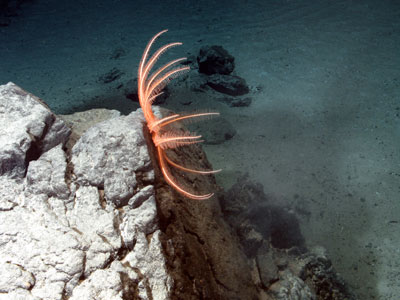The hydrothermal field Ashadze-1 was discovered at 12°58.4’N,
44°51.8’W on the Mid-Atlantic Ridge (MAR) in
2003 during the 24th cruise of R/V Professor Logatchev. The hydrothermal
field is located at a depth of 4100-4200 m
at the foot of the western slope of the MAR rift valley. Structurally,
the field is related to the intersection of a deep
along-axis marginal fault and a transverse sublatitudinal tectonic dislocation.
Serpentinized peridotites form the host
rocks within the hydrothermal field
Ashadze-1 was the deepest known active hydrothermal
vent field, before they found the Cayman Ridge's
vents.
The first observations on this site were numerous clear and black smokers
and surprisingly few known symbiotic
species ominant in other vent areas on the Mid Atlantic Ridge (MAR).
 Temperature
measurement of one smoker of Ashadze
Temperature
measurement of one smoker of Ashadze
http://www.ifremer.fr/serpentine/english/07-03-13.htm
Photo : © Ifremer / Serpentine 2007 |
The species most abundant at Ashadze-1 are those
usually found at the periphery of hydrothermal communities: sea-
anemones. Maractis rimicarivora, and chaetopterid polychaetes
hyllochaetopterus sp. ov. This study comprised site
mapping and faunal sampling and Ashadze-1 was completely mapped using
the Remote perated Vehicle ‘Victor 6000’
and a new high resolution tool available for deep-sea research.
A photo-mapping survey was carried out with a long range optical black
and white camera. Digitization of substrata and
sea-anemones visible on the images was performed by GIS. Spatial distribution
of Ma. rimicarivora was distinguished by
high densities of 32 ind.m22 on the western side of the main smoker
area.

Site W is covered with a thin layer of grey particles. Site E
is located in the sediment 2 m from SE1.
See map below. |
This field was revisited during the 26th cruise of R/V Professor Logatchev
in January-March 2005.
As a result of the investigations during this cruise, two new hydrothermal
sites were discovered in the vicinity of
the Ashadze-1 field
The first new site (Ashadze-2) is situated 2.5 miles to thenorthwest
of Ashadze-1 at 12°59.5´N, 44°54.4´W.
It is located in the northern part of a wide terrace of the central
valley slope at depths of 3200 - 3300 m.
It lies in a graben-like structure joining the latitudinal fault zone
from the north . Fragments of sulfide chimney
walls, as well as totally oxidized chimney fragments.

Site SE1 appears to be very clean and orange.Site SE2 is completely
covered by sediment
at the bottom of the ‘Long chimney’.
See map below |
The three discovered hydrothermal sites along the western slope of
the rift valley which are both hydrothermally
active and extinct, are copper rich and spatially associated with non-basaltic
rocks.
The benthic-megafauna community observed is dominated by two species,
namely the sea-anemone Ma. rimicarivora
and the chaetopterid Phyllochaetopterus sp. nov. These species form
large populations on different substrata,
such as the walls of active and old chimneys and on old pieces of fallen
chimneys and for the most part covered
by hydrothermal sediments.
 Beautiful
bouquet of anemones, harvested 4200 feet deep
Beautiful
bouquet of anemones, harvested 4200 feet deep
http://www.ifremer.fr/serpentine/english/07-03-13.htm
Photo : © Ifremer / Serpentine 2007 |
Specimens were sampled at 4 sites: on the eastern part (SE1) and on
the western part (W) of the ‘Anemone garden’,
at the base of the ‘Long chimney’ (SE2) and in the sediment
2 m east (E) of the ‘Anemone garden’.
These four sites can be distinguished: the first (SE1) was at the base
of active and fresh sulphide chimneys;
the second (W) was also very similar but covered by grey hydrothermal
sediment, probably stemming from the three
black smokers; the third (SE2) was characterized by very black hydrothermal
sediment covering pieces of hard
substratum, and the last (E) was composed of two layers, a top layer
8-cm thick composed of orange-brown oxidized
sediment and an underlying grey one.
 Sponges
as big as sea urchins!
Sponges
as big as sea urchins!
http://www.ifremer.fr/serpentine/english/07-03-13.htm
Photo : © Ifremer / Serpentine 2007

Animal communities near an active smoker
http://www.ifremer.fr/serpentine/english/07-03-13.htm
Photo : © Ifremer / Serpentine 2007

Echinodermata Brisingidae
http://www.ifremer.fr/serpentine/english/07-03-13.htm
Photo : © Ifremer / Serpentine 2007
|
Text and
prictures are collected from the following sources:
The hydrothermal vent community of a new deep-sea field, Ashadze-1,
12°58'N on the Mid-Atlantic Ridge.
Journal of the Marine Biological Association of the United Kingdom
http://www.epjap.org/action/displayFulltext?fromPage=online&type=6&fid=S0025315409991561&aid=7923626&next=true&jid=MBI&volumeId=90&issueId=08&next=Y#sec2-6
Fabri Marie-Claire, Bargain Annaelle, Briand Patrick, Gebruk A., Fouquet
Yves, Morineaux Marie, Desbruyeres Daniel (2011).
The hydrothermal vent community of a new deep-sea field, Ashadze-1,
12°58'N on the Mid-Atlantic Ridge.
Journal Of The Marine Biological Association Of The United Kingdom,
91(1), 1-13. Publisher's official version : http://dx.doi.org/10.1017/S0025315410000731
, Open Access version : http://archimer.ifremer.fr/doc/00004/11565/
Bel’tenev V., A. Nescheretov, V. Shilov, V. Ivanov, A. Shagin,
T. Stepanova, G. Cherkashev, B. Batuev, M, Samovarov, I. Rozhdestvenskaya,
I. Andreeva, I. Fedorov, M.
Davydov, L. Romanova, V. Zaharov, N. Luneva, O. Artem¢eva, A. Rumyantsev.
New discovered at 12°58’ N, 44°52’ W, MAR:Professor
Logatchev-22 cruise, initial results // InterRidge News 2003. Vol. 12
(1). pp. 13-14.
http://www.ifremer.fr/serpentine/english/07-03-13.htm.
Photo : © Ifremer / Serpentine 2007
|









